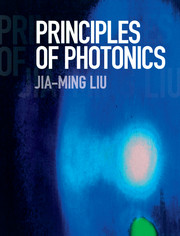Book contents
- Frontmatter
- Dedication
- Contents
- Preface
- Partial List of Symbols
- 1 Basic Concepts of Optical Fields
- 2 Optical Properties of Materials
- 3 Optical Wave Propagation
- 4 Optical Coupling
- 5 Optical Interference
- 6 Optical Resonance
- 7 Optical Absorption and Emission
- 8 Optical Amplification
- 9 Laser Oscillation
- 10 Optical Modulation
- 11 Photodetection
- Appendix A Symbols and Notations
- Appendix B SI Metric System
- Appendix C Fundamental Physical Constants
- Appendix D Fourier-Transform Relations
- Index
- References
10 - Optical Modulation
Published online by Cambridge University Press: 05 August 2016
- Frontmatter
- Dedication
- Contents
- Preface
- Partial List of Symbols
- 1 Basic Concepts of Optical Fields
- 2 Optical Properties of Materials
- 3 Optical Wave Propagation
- 4 Optical Coupling
- 5 Optical Interference
- 6 Optical Resonance
- 7 Optical Absorption and Emission
- 8 Optical Amplification
- 9 Laser Oscillation
- 10 Optical Modulation
- 11 Photodetection
- Appendix A Symbols and Notations
- Appendix B SI Metric System
- Appendix C Fundamental Physical Constants
- Appendix D Fourier-Transform Relations
- Index
- References
Summary
TYPES OF OPTICAL MODULATION
Optical modulation allows one to control an optical wave or to encode information on a carrier optical wave. The inverse process that recovers the encoded information is demodulation. There are many types of optical modulation, which can be categorized in several different ways.
1. According to the particular optical-field parameter being modulated, optical modulation can be categorized into different modulation schemes: phase modulation, frequency modulation, polarization modulation, amplitude modulation, spatial modulation, and diffraction modulation.
2. Depending on whether the information is encoded in the analog or digital form, optical modulation can be either analog modulation or digital modulation.
3. Optical modulation can be categorized as direct modulation or external modulation. Direct modulation is directly performed on an optical source, which is usually a light-emitting diode (LED) or a laser, without using a separate optical modulator. External modulation is performed on an optical wave using a separate optical modulator to change one or more characteristics of the wave.
4. Optical modulation is accomplished by varying the optical susceptibility of the modulator material. Depending on whether the real or imaginary part of the susceptibility is responsible for the functioning of the modulator, optical modulation can be categorized as refractive modulation or absorptive modulation. Refractive modulation is performed by varying the real part of the susceptibility, thus varying the refractive index of the material; absorptive modulation is performed by varying the imaginary part of the susceptibility, thus varying the absorption coefficient of the material.
5. Optical modulation can be categorized according to the physical mechanism behind the change of the optical susceptibility, such as electro-optic modulation, acousto-optic modulation, magneto-optic modulation, all-optical modulation, and so forth.
6. Depending on the geometric relation between the modulating signal and the modulated optical wave, optical modulation can be transverse modulation or longitudinal modulation. In transverse modulation, the signal is applied in a direction perpendicular to the propagation direction of the optical wave. In longitudinal modulation, the signal is applied along the propagation direction of the optical wave.
7. Optical modulation can be performed on unguided or guided optical waves. Correspondingly, the structure of an optical modulator can take the form of a bulk or waveguide device. A bulk modulator is used to modulate an unguided optical wave. A waveguide modulator is used to modulate a guided optical wave.
- Type
- Chapter
- Information
- Principles of Photonics , pp. 297 - 361Publisher: Cambridge University PressPrint publication year: 2016
References
- 2
- Cited by



